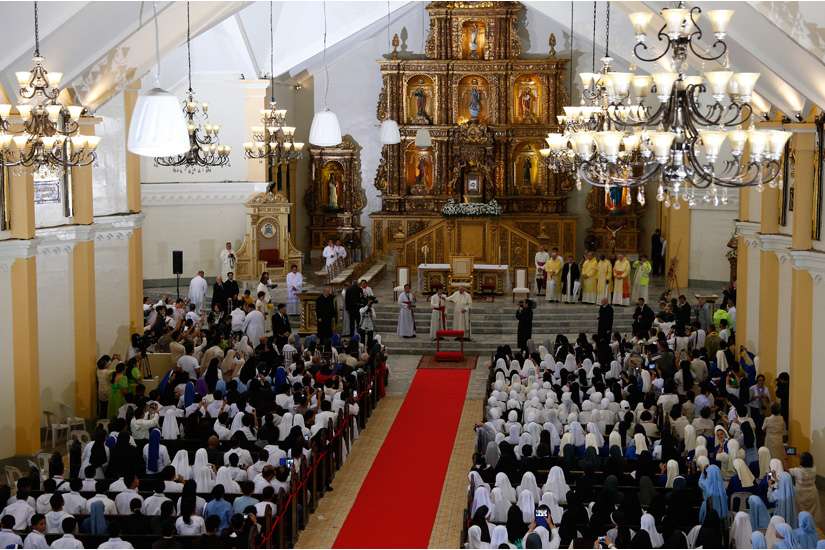The Pope arrived at Tacloban International Airport a little before 9 a.m. Jan. 17, after a bumpy 75-minute-long flight from Manila. For his short ride in an open-sided popemobile to the site of the open-air Mass, he donned the same kind of yellow plastic poncho worn by the hundreds of thousands of people awaiting him in the rain. He kept the poncho on while he celebrated Mass, as strong winds blew.
For his homily, the Pope abandoned his prepared English text to improvise in his native Spanish with the aid of an interpreter.
He recalled his initial reaction, on Nov. 8, 2013, to the typhoon that claimed some more than 7,300 lives and destroyed more than 1 million homes.
"When I saw that catastrophe from Rome, I felt that I had to be here, and on that day I decided to be here. Now I have come to be with you -- a little bit late, but I am here," the Pope said.
"I have come to tell you that Jesus is Lord and he never lets us down. 'Father,' you might say to me, 'he defrauded me, because I lost my house, I lost what I had, I am sick.' That's true, if you would say that, and I respect those sentiments. But I see him there nailed to the cross and from there he does not let us down," Pope Francis said.
"So many of you have lost everything I don't know what to say to you. But he does know what to say to you," the Pope said.
"And beside him on the cross was his mother," the Pope said, pointing to a statue of Mary holding the baby Jesus. "We are like that little child there. In moments of pain, when we no longer understand and want to rebel, all we can do is grab hold of her hand firmly and tell her 'mom,' as a child says to his mother when he is afraid. Maybe that is the only word we can say in such difficult times: 'mother, mom.'"
Pope Francis concluded on a solemn yet hopeful note, drawing a link between the consolation of faith and the solidarity among those working to rebuild the area.
"We have a mother, we have our older brother Jesus, we are not alone," the Pope said. "We also have many brothers who in this moment of catastrophe came to help us. And we, too, feel more like brothers and sisters because we have helped each other."
"Let us move forward, always forward, and walk together as brothers and sisters in the Lord," he said, before the entire congregation observed a moment of silence.
After the Pope's departure, strong winds caused scaffolding in an area near the altar to fall and hit two women. The accident killed Kristel Padasas, 27, of Manila, a Catholic Relief Services employee on a Typhoon Haiyan recovery project who had attended the papal Mass as a volunteer.
Jesuit Father Federico Lombardi told reporters later in the day that Pope Francis was consulting with advisers on the best way to reach out to the dead woman's family.
The accident left the other woman, Darla Santos, 19, with a dislocated hip.
The Pope carried out all the remaining events on his official agenda in a highly abbreviated fashion, so that the plane taking him back to Manila could take off before the worst of the storm hit the area.
At a planned lunch with typhoon survivors, the Pope managed to taste some salad and cold soup while urging others present to eat more, Cardinal Luis Antonio Tagle of Manila told reporters later.
A visit to the house of a local fisherman, intended to give the Pope a closer look at the life of ordinary survivors, lasted 10 minutes. Stopping at the new Pope Francis Center for the Poor, which had been built with Vatican funds, the Pope blessed the building without getting out of his popemobile.
A planned prayer service at the cathedral in Palo, less than 10 miles away from Tacloban, turned into a brief talk by the Pope followed by a recital of the Hail Mary. The Pope also led the congregation in a round of "Happy Birthday" for a member of his entourage, Cardinal Pietro Parolin, the Vatican secretary of state.


